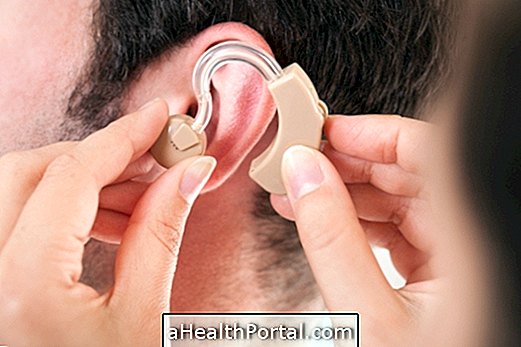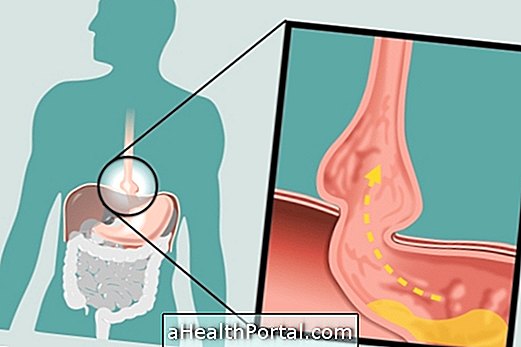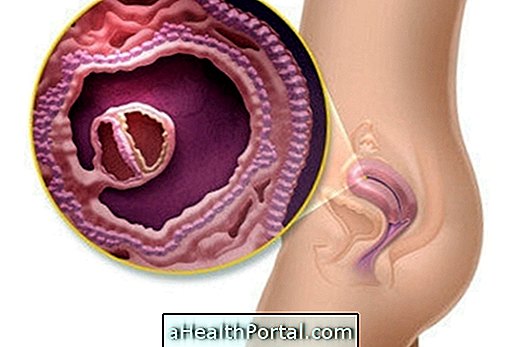The hearing aid, also called an acoustic hearing aid, is a small device that must be placed directly on the ear to help increase the volume of sounds, making it easier for people who have lost this function to be of any age. older people who lose their hearing because of aging.
There are several types of hearing aids, both internal and external to the ear, consisting of a microphone, a sound amplifier, and a speaker, which increases the sound to the ear. For your use, it is necessary to go to the otorhinolaryngologist and do audition exams, such as audiogram, to know the degree of deafness, which can be light or deep, and choose the most appropriate device.
In addition, there are several models and brands, such as Widex, Siemens, Phonak and Oticon, for example, in addition to various formats and sizes, and possibility to use in one ear or both.

Hearing aid price
The price of the hearing aid depending on the type and brand of device, and can vary between 8 thousand and 12 thousand reais.
However, in some states of Brazil, the hearing impaired patient may have access to a hearing aid free of charge, through the SUS, after the physician's indication.
When to use
Hearing aids are indicated by the otolaryngologist for cases of deafness due to hearing system wear, or when there is a situation or illness that causes difficulty in the arrival of sound in the inner ear, such as:
- Sequelae of chronic otitis;
- Alteration of ear structures by trauma or disease, such as otosclerosis;
- Damage of the cells of the ear by excess of noise, by work or listen to music very loud;
- Presbycusis, in which degeneration of the ear cells occurs due to aging;
- Tumor in the ear.
When there is any type of hearing loss, the otorhinolaryngologist should evaluate the type of deafness and confirm if there is a need for hearing aids or if any medication or treatment surgery is necessary. Next, the speech therapist will be the professional responsible for indicating the type of device, besides adapting and accompanying the hearing aid to the user

In addition, in case of deeper sensorineural deafness, or when there is no improvement in hearing with the hearing aid, cochlear implantation may be necessary, an electronic device that directly stimulates the auditory nerve through small electrodes that lead the electrical signals to the brain that interprets them as sounds, totally replacing the ear of people who have severe deafness. Learn more about pricing and how cochlear implant works.
Types of appliance and how they work
There are different types and models of hearing aid, which should be guided by the doctor and speech therapist. The main ones are:
- Retroauricular, or BTE: is the most common, used embedded in the upper outer part of the ear, and connected to the ear by a thin tube that conducts the sound. It has internal programming controls, such as volume control, and battery compartment;
- Intracanal, or ITE: is for internal use, being fixed inside the ear canal, manufactured specifically for the person who will use, after performing an ear mold. Can have internal or external control with volume knob and programming for function control, and battery compartment;
- Deep intracanal, or RITE: it is the smallest model, with digital technology, of internal use, because it fits completely inside the auditory canal, being practically invisible when placed. Fits very well for people with mild to moderate hearing loss.
The internal appliances have a higher cost, however, the choice between these models is made according to the needs of each person. For its use, it is advisable to do auditory rehabilitation training with the speech-language pathologist to allow better adaptation and, in addition, the doctor can indicate a period of home testing to see if there is adaptation.


How to maintain your hearing aid
The hearing aid must be handled with care since it is a fragile device that can easily break and therefore it is important to remove the device whenever you take a bath, exercise or sleep.
In addition, it is important to bring the device to the hearing aid store at least 2 times a year for maintenance and whenever it is not working properly.
How to clean
To clean the BTE, you should:
- Switch off the appliance by the on-off or on-off button and separate the electronic part from the plastic part, holding only the plastic mold;
- Clean the plastic mold with a small amount of audioclear spray or wipe the wiping wipe;
- Wait 2 to 3 minutes to let the product act;
- Remove excess moisture from the plastic tube of the appliance with a specific pump that sucks the liquid;
- Clean the appliance with a cotton cloth, such as the cloth to wipe goggles, to dry well.
This procedure should be done once a month and every time the patient feels they are not listening as well as the tube of the device may be dirty with wax.
The cleaning of the intracanal appliance is done by wiping a soft cloth on its surface, while cleaning the sound outlet, the microphone opening and the ventilation channel must use the supplied cleaning utensils, such as small brushes and wax filters.
How to change the battery
Generally, the batteries last for 3 to 15 days, however, the change depends on the brand of the device and the battery, and the amount of daily use and, in most cases, the hearing aid indicates when the battery is weak, doing beep.
To change the battery, it is usually necessary to bring a magnetic magnet closer to remove the battery. After removing the spent battery, it is necessary to fit a new and charged battery for the device to work properly.






















